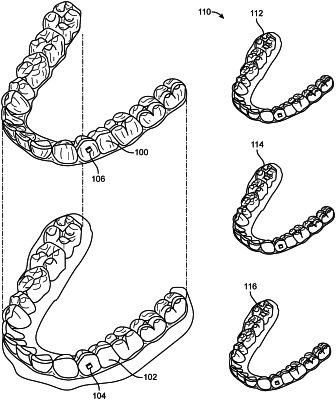| CPC A61C 7/002 (2013.01) [A61C 7/08 (2013.01); G06T 17/20 (2013.01); G16H 20/00 (2018.01); G06T 2207/30036 (2013.01)] | 18 Claims |

|
1. A computer-implemented method for digital treatment planning, the computer-implemented method comprising:
defining a plurality of caps, wherein each cap of the plurality of caps represents a set of contact points on a tooth of a patient's dentition;
defining a plurality of links, wherein each link of the plurality of links represents a connection between a pair of the plurality of caps;
generating a relaxed model of a dental appliance using the plurality of caps and the plurality of links, wherein the relaxed model represents physical properties of the dental appliance prior to use by the patient;
generating a deformed model of the dental appliance using the plurality of caps and plurality of links, wherein the deformed model of the dental appliance represents physical properties of the dental appliance after use by the patient; and
transforming the relaxed model to the deformed model to direct the patient dentition towards a target tooth arrangement,
wherein the plurality of caps and the plurality of links are defined at least in part based on an initial three-dimensional model of the patient's dentition; wherein the initial three-dimensional model of the patient's dentition is collected from an intraoral scan of the patient's mouth.
|